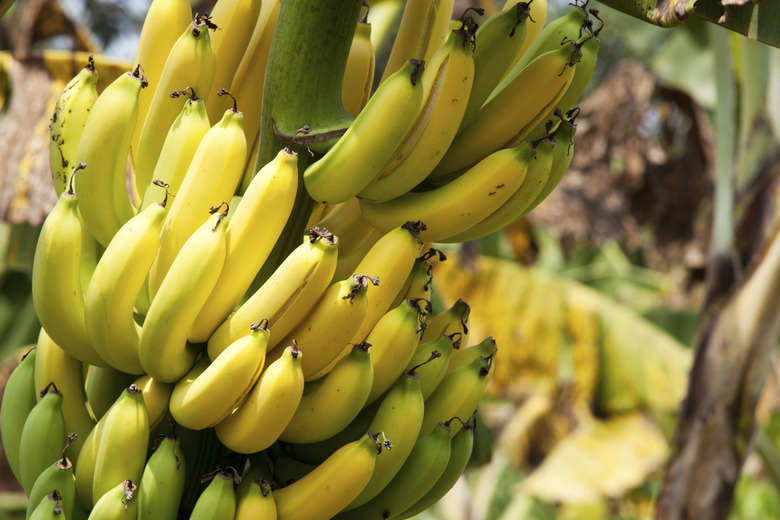Life Cycle Of Banana Plants
We may receive a commission on purchases made from links.
Bananas (Musa spp.) range from tropical to hardy as perennials in U.S. Department of Agriculture plant hardiness zones 6 through 11 depending on the species. These herbaceous perennials grow rapidly from rhizomes or root suckers into 6- to 25-foot-tall "trees." Whether a tropical or hardy species or grown as a houseplant or in the garden, the life cycle of banana plants is essentially the same.
Tropical Banana Plant
Tropical Banana Plant
Musa acuminata 'Dwarf Cavendish,' is an edible yellow banana that is hardy in USDA zones 9 through 11. While it thrives in warm, frost-free locations or as a container plant that's taken indoors in fall, it's more often grown as a large houseplant placed in a warm sunroom or a sunny, south-facing window. Though an indoor plant may not bloom and produce bananas, Dwarf Cavendish is a cultivar in the same species as those found in grocery stores.
Hardy Banana Trees
Hardy Banana Trees
The Japanese banana (Musa basjoo), also known as hardy fiber banana or hardy banana, is a perennial in USDA zones 6 through 10. This species is evergreen in USDA zones 9 and 10, and with heavy mulching, it grows back from the roots in colder zones.
Hardy in USDA zones 7b through 11, the pink velvet banana (Musa velutina) grows up to 6 feet tall. Grown for its ornamental value rather than its pink, hairy and seed-filled edible bananas, this banana plant can produce flowers and fruits in its first year.
Life Cycle of Banana Plants
Life Cycle of Banana Plants
Banana trees spread by rhizomes and root suckers. If the large leaves are damaged by wind or marauding children or pets, the plant will resprout rapidly if you prune it back to the ground. In colder climates, banana plants grow back from the roots when the weather warms in spring. When grown indoors or in warm climates, they stay green and grow year-round.
After planting the rhizome, a swirl of folded banana leaves grows. The true stem grows up from the middle of the folded leaves, or pseudostem, and produces leaves, flowers and eventually bananas. The timing of flowers varies depending on the species and cultivar. The pink velvet banana can produce flowers the first year, and Dwarf Cavendish flowers may require nine to 15 months to appear, while hardy bananas may take up to 24 months to set fruit.
After producing flowers and fruits, the pseudostem dies. The roots push out new shoots, or pups, which grow into new pseudostems. If your plant produces fruits and seeds, you can sow the seeds in moist potting mix. Be patient because they may take up to six months to germinate.
Banana Plant Care
Banana Plant Care
Banana plants need a well-draining, organically rich soil to thrive. Water when the soil is dry to a depth of 2 inches. Keep the soil evenly moist but not waterlogged. Fertilize every two to three weeks when the plant is actively growing using a liquid fertilizer formulated for houseplants.
Place your banana plant in full sun outside in summer and in a warm, sunny window or sunroom in winter. A grow light or fluorescent fixture suspended a few inches above the plant adds additional light. Keep the plant warm. While the hardier bananas can tolerate lower temperatures, anything under 60 degrees Fahrenheit can damage a Dwarf Cavendish.
When grown outdoors, even the hardy banana species need protection from cold and freezing temperatures. When the leaves die back in winter, cut the stem to 2 to 3 feet tall. Wrap the remaining stem in burlap or bubble wrap and then apply a thick layer of mulch over the soil and around the stem. Remove the covering when the weather warms in spring; the plant will grow back from its roots.
